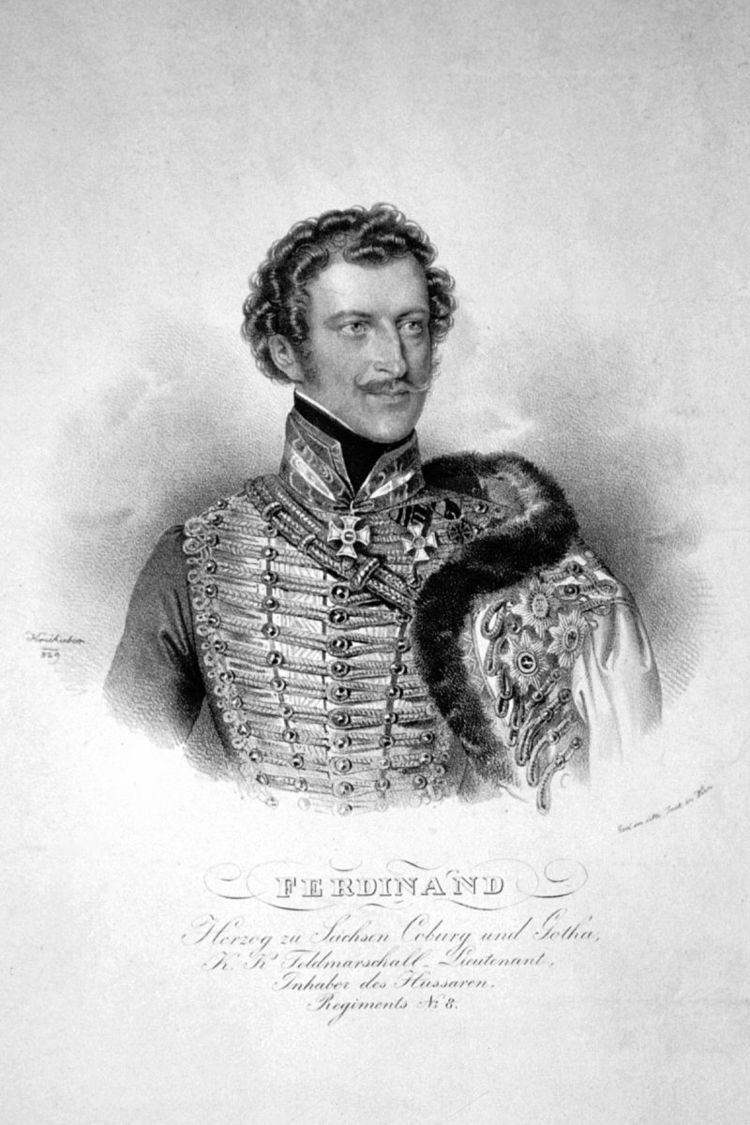Founded 1826 | ||
 | ||
Titles Prince of Saxe-Coburg and GothaKing of Portugal and the Algarves (1837–1910)Prince of Bulgaria (1887–1908)Tsar of Bulgaria (1908–1946) Final ruler Prince Philipp; no family head since abolition of fideicommiss | ||
The House of Saxe-Coburg-Gotha-Koháry is the Catholic cadet branch of the House of Saxe-Coburg and Gotha. It was founded after the marriage of Prince Ferdinand of Saxe-Coburg and Gotha with Princess Maria Antonia Koháry de Csábrág. Among its descendants were the last four kings of Portugal (Pedro V, Luis I, Carlos I, Manuel II) and the last three Tsars of Bulgaria (Ferdinand I, Boris III, Simeon II).
Contents
History
After the marriage of Prince Ferdinand of Saxe-Coburg and Gotha with Princess Maria Antonia Koháry de Csábrág in January 1816 and the death of his father-in-law, Prince Ferencz József Koháry de Csábrág, in 1826, Prince Ferdinand inherited the Hungarian princely estate of Koháry and converted to Roman Catholicism.
The descendants of this branch managed to marry an imperial princess of Brazil, an archduchess of Austria, a royal princess of "the French", a royal princess of Belgium, and a royal princess of Saxony. A scion of this branch, also named Ferdinand, became Prince, and then Tsar, of Bulgaria, and his descendants continued to rule there until 1946. The current head of the House of Bulgaria, the former Tsar Simeon II who was deposed and exiled after World War II, goes by the name Simeon Sakskoburggotski and served as Bulgaria's prime minister from 2001 to 2005.
Prince Ferdinand and Princess Maria Antonia had four children, all of whom were raised Catholic:
- Ferdinand II of Portugal (1816–1885), was the husband of Queen Maria II of Portugal.
- August (1818–1881), was the father of Ferdinand I of Bulgaria.
- Victoria (1822–1857), married Louis, Duke of Nemours.
- Leopold (1824–1884).
House of Braganza-Saxe-Coburg and Gotha
The royal House of Braganza-Saxe-Coburg and Gotha is a cadet branch of the House of Saxe-Coburg-Gotha-Koháry. This royal house was founded by Prince Ferdinand, who on 9 April 1836 married Queen Maria II of Portugal from the House of Braganza.
Ducal branch
After the death of his father in law, Franz Joseph Koháry, Prince Ferdinand of Saxe-Coburg and Gotha reorganised the family fortune in two Fideicommisses and adopted the title of duke for himself and his successors as Fideikommissherr. After his death in 1851, and that of his wife Maria Antonia in 1862, Prince August became the head of the family. The eldest son, Ferdinand, had to renounce his rights when he married Queen Maria II of Portugal.
After Prince August died, his eldest son Prince Philipp (1844–1921) became the head of the family. Prince Philipp's only son died before him, so his grand-nephews Prince Rainer and Prince Philipp inherited the fortune in 1921. In 1938, the family Fideikommisses were abolished.
Brazilian line
Prince Ludwig August was the second son of Prince August of Saxe-Coburg and Gotha and Clémentine of Orléans. On 15 December 1864, he was married in Rio de Janeiro to Princess Leopoldina of Brazil. They had four sons, with Prince Pedro Augusto of Saxe-Coburg and Gotha being the eldest son. After the fall of the Brazilian Empire in 1889, the family returned to Europe. Prince Rainer, who was appointed head of the house in 1921, was a grandson of Prince Ludwig August.
Bulgarian branch
Ferdinand I of Bulgaria was the youngest son of Prince August of Saxe-Coburg and Gotha and Clémentine of Orléans. In 1887, he became the ruler of Bulgaria. The current Bulgarian royal family descends from him.
Fideicommiss
Princess Maria Antonia Koháry inherited over 150000 hectares of land in Lower Austria, Hungary and Slovakia, including estates, forests, mines and factories. According to a list of assets appended to the marriage contract of her son, Prince August, at the time of his marriage to Princess Clémentine of Orléans in 1843, the Koháry properties included the enormous Palais Koháry in the center of Vienna and several Viennese manors, a summer home and lands at Ebenthal, Lower Austria, estates in Austria at Velm, Durnkrut, Walterskirchen, Bohmischdrut and Althoflein, as well as a dozen manors in Hungary, the domaine of Kiralytia, and a mansion at Pest. As late as 1868, when Antónia's grandson Prince Ferdinand, Duke of Alencon, married, it was estimated that he and his three siblings stood to inherit a total of a million francs just from their share of their late grandmother's estate.
After the death of his father in law, Franz Joseph Koháry, Prince Ferdinand of Saxe-Coburg and Gotha reorganised the family fortune in two Fideicommisses and adopted the title Duke for him and his successors as Fideikommissherr. Until the first world war, her descendants, the Koháry branch of the House of Saxe-Coburg and Gotha, were among the three largest landowners in Hungary.
The two fideicommisses allowed to hold the family property in foundations owned by the whole family, but governed by the head of the family alone, the Fideicommissherr. Aristocratic families had used this instrument to finance the representative household of the head of the family as well as to maintain palaces and castles, and to pay allowances to family members without personal wealth. Fideikommisses were abolished in Austria after the Anschluss 1938.
Burial site
In 1851, a committee headed by Prince August of Saxe-Coburg and Gotha set out to plan the construction of a Roman Catholic church in Coburg with a burial vault underneath. St. Augustin was opened on 28 August 1860. The crypt contains the remains of fifteen members of the Koháry branch of the House of Saxe-Coburg.
